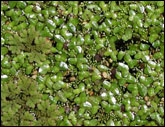FAQ - Plants - Filtering Plants“Filtering plants” is a term used for a group of plants that are useful to the pond owner because they are able to remove nutrients from the water through their often large roots systems. Like plants that are grown hydroponically, these plants are able to derive their entire nutrient supply directly from the water as dissolved compounds. The nutrients are the byproducts of the decay of proteins and the conversion of minerals that occur every day in your pond. The primary organ of nutrient absorption in plants is, of course, the root system. To a far lesser degree, many plants are able to get their nutrients from the water through the leaves, but these are strictly submergent species, and are more properly covered in the section on “Oxygenators”. Filtering plants are those that compete with algae by deriving nutrient directly from the water through the roots. Of course, they can only remove nutrients from the water that they “see” in a day, so it makes sense to place the bulk of these plants in the pond where water flows through. Preferably, this water come directly from the filter because this water has the greatest load of plant nutrients. The more of the nutrients that can be removed from the water before it gets to the main body of the pond, the less algae will grow in the pond as a whole. Proper vs. improper placement of the plants can easily make the difference between success and failure in the pond. The list of species that fall into this category is long and varied. It includes many plants that are also included in the category of plants that we refer to as “emergent marginals”. The most common varieties are Myriophyllum brasiliense (Parrot’s Feather), Ludwigia repens, L. peploides (Creeping Water Primroses), Rorripa aquatica (Water Cress), Eichornia crassipes (Water Hyacinth), and Pistia stratioides (Water Lettuce). Other species include Ludwigia sedioides (Mosaic Plant), L. palustris, Aeschenomene fluitans (Creeping Bog Pea), Neptunia repens (Water Sensitive Plant), Wedellia trilobata (Creeping Bog Daisy), etc. Most of these species can be grown along the margins of ponds, planted in the rocks and gravel or in soil filled trays at intervals around the perimeter of the pond or in the stream or water fall pool(s). Again, it is best to plant them in areas that the water must flow through to use them to them most efficiently. |
|||||
|
Your Account
Gift Certificate
|








